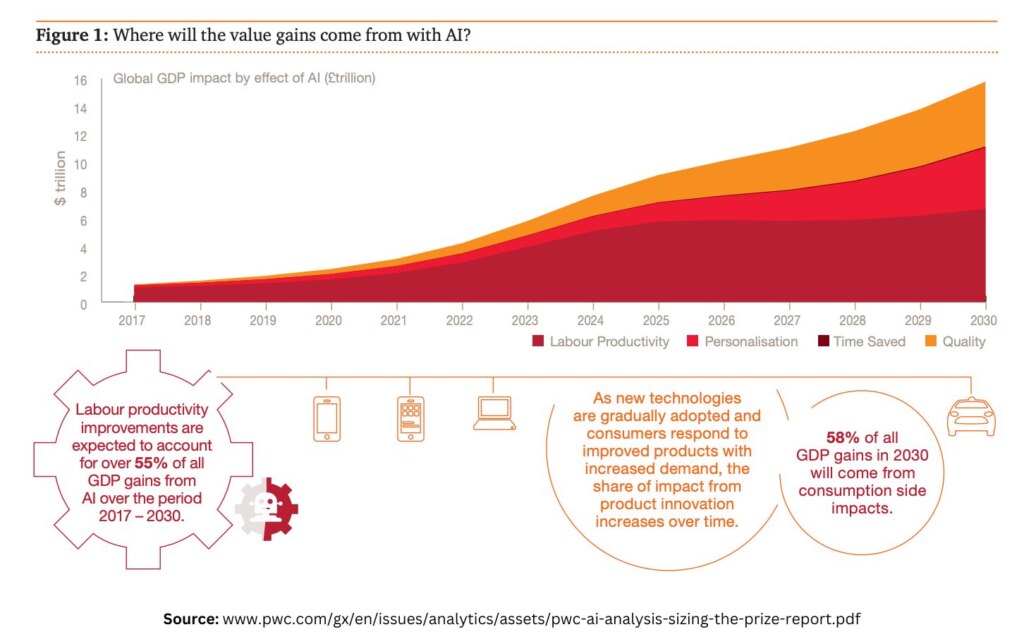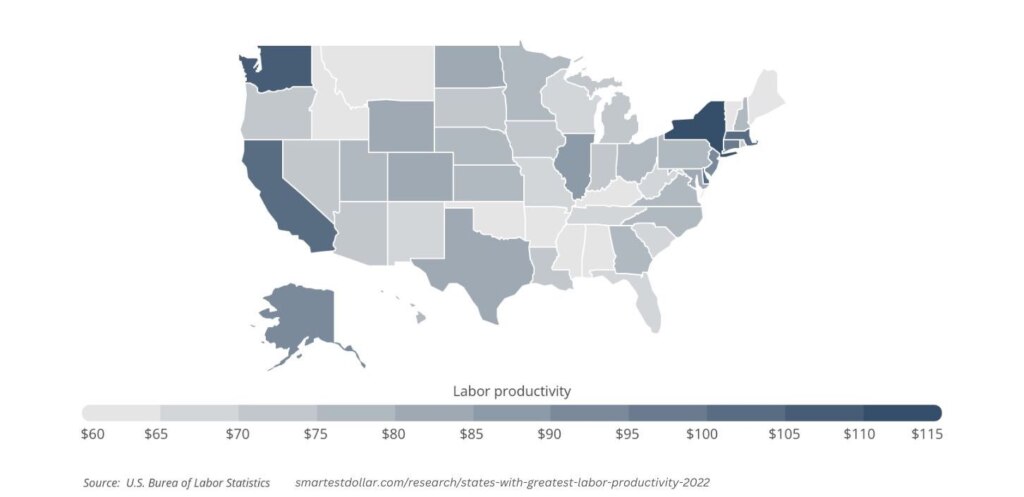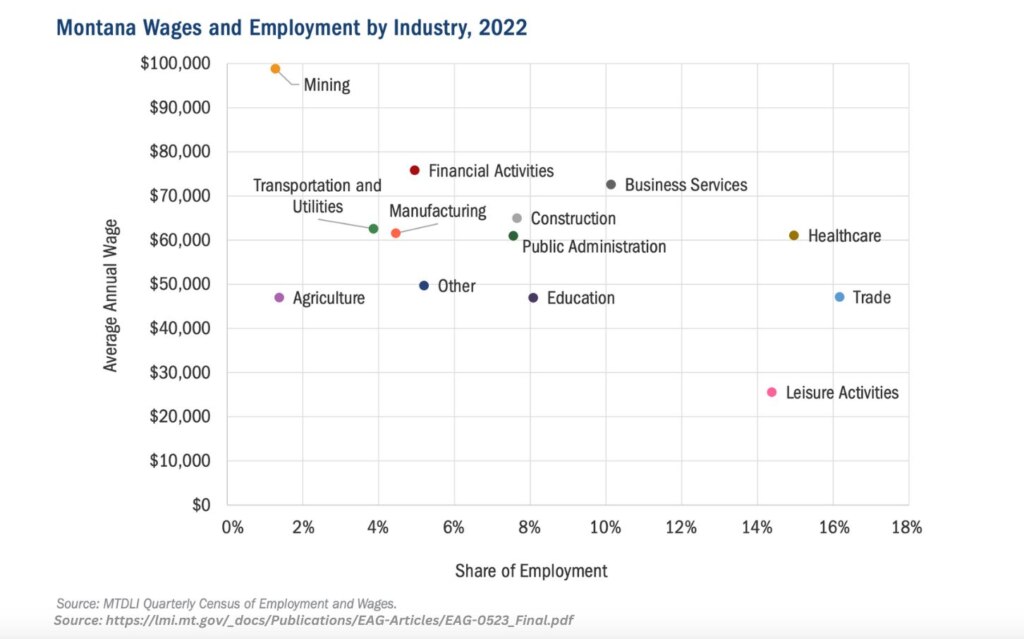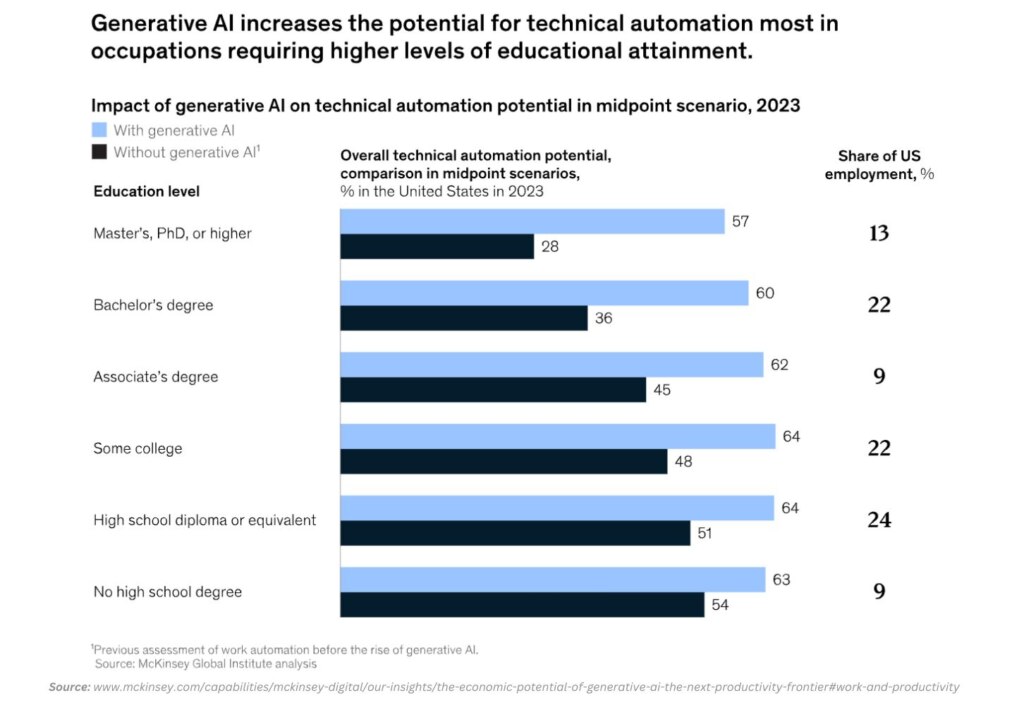In the prior Montana 2050 Report, I discussed how the increasing importance of data in the economy of the future has presented Montana with the opportunity to attract the data center industry to the state and position itself as the Last Best Place to compute.
Continuing with the goal to assess the current and future technological landscape to identify opportunities that will enable Montana to lead the economy of the future, in this report I will be looking into one of the most exciting and innovative technologies driving demand for data and computational power: Artificial Intelligence.
Background
Most of human history has been characterized by information scarcity, where information was hard to acquire and share with others. Over time information scarcity was slowly eroded by transformative innovations like the printing press, the telegraph, the radio, and the pinnacle of them all: the internet.
The increase in information abundance presented a new problem: how do we get people the information they need and care about?
To answer this question a litany of innovations have arisen, but all answers have been paled in comparison to the creation of Artificial Intelligence (AI).
What is AI?
AI is the application of mathematics in computing to help computers understand information. As tech founder Marc Andreessen has put it, “AI is a computer program like any other – it runs, takes input, processes, and generates output.”
While there are a variety of different approaches for creating a functioning AI system, they all share the similarity of using computer mathematics to analyze data, identify patterns and create an output.
AI services and applications incorporate a combination of several subsets of AI technology. Here are the major subsets:
- Machine Learning: This field of AI focuses on the development of algorithms that can learn from and make predictions or decisions based on data. The sophistication of a machine learning model can generally be traced back to the amount of data the system was trained with and the computational resources needed for training. Simpler examples include email spam filters and spell checkers. An advanced machine learning model like OpenAI’s GPT-4 is estimated to have been trained on 4.9 trillion data points.
- Deep Learning/Neural Networks: A highly sophisticated type of machine learning model that uses neural networks, a series of algorithms and nodes inspired by the way the human brain operates with many layers (hence “deep”) to process vast amounts of undefined data and recognize patterns. It is particularly well suited for handling complex, high-dimensional data such as images and audio.
Examples: Voice recognition in virtual assistants like Siri and Alexa, photo tagging on social media.
- Natural Language Processing (NLP): NLP involves the interaction between computers and humans through natural language. The ultimate objective of NLP is to read, decipher, understand, and make sense of human languages in a valuable way. Machine Learning and Neural Networks are the primary tools in NLP.
Examples: Translation services like Google Translate. Popular Chat AIs like ChatGPT, Grok, etc. are also classified under NLP.
- Computer Vision: This area focuses on enabling machines to visually interpret the world and make decisions and actions based on visual inputs. It deals with object recognition, image generation, video analysis and more.
Examples: Facial recognition systems used for security purposes, and Tesla Autopilot.
- Robotics: Robotics involves programming computers to see, hear, and react to sensory input to perform tasks or functions. This is a more physically oriented subset, dealing with the control of robotic arms, autonomous vehicles, drones, etc.
Examples: Industrial robots for manufacturing, and Roomba vacuum cleaners.
- Expert Systems: These are AI systems that leverage rules-based systems to emulate the decision-making ability of a human expert. They are used in applications like medical diagnosis, legal compliance, financial services, etc.
Example: Merative, formerly known as IBM’s Watson Health, which can diagnose diseases or provide expert advice in various domains.
Who can build AI?
In theory, anyone with access to a capable computer, large data sets, and knowledge of software programming and machine learning algorithms can create an AI system.
Open vs Closed Source AI
There is a debate in the AI industry whether to create AI systems that are open-source or closed-source:
- Open-Source AI is a decentralized approach to constructing AI where the source code is freely available for anyone to review, use, modify and distribute. Open-source projects aim to allow AI to proliferate freely and transparently to maximize competition and innovation. Critics of open-source projects say the access and use of AI systems should be controlled, limited and regulated.
Examples: IBM & NASA’s development of an open-source Geospatial AI, and Nonprofit Ersilia’s open-source AI model designed to fast track medical research of neglected or infectious diseases.
- Closed-Source AI is a centralized approach to constructing AI where the source code is kept proprietary and not freely available to the public. Closed-source projects prioritize centralized quality control, safety and compliance to prevent “misuse.” Critics of closed-source projects say algorithms can be manipulated to push particular agendas and reduce the potential of AI to benefit humanity.
Examples: Google Gemini’s woke AI, and OpenAI’s ChatGPT (which became closed-source in 2016).
Why does AI matter?
The AI industry is anticipated to grow by 19% per year, reaching a revenue of $900 billion by 2026.
However, it is not just the AI industry itself that will benefit from the technology. As AI becomes more sophisticated, it has the promise of democratizing information – allowing anyone, regardless of their background or expertise, to access and leverage vast amounts of data and insights.
The results of AI democratizing knowledge will be heightened innovation, amplified labor productivity, and a broader distribution of opportunities, leading to an estimated contribution of up to $15.7 Trillion to the global economy by 2030. We should aim to attract this high-growth industry to Montana.

It is also important to note that the growth of labor productivity is a major contributing factor to real wage growth and improved living standards. High labor productivity means goods and services can be produced with less work, which lowers the costs of goods for everyone, increases economic growth, and drives up wages (more productive workers are more valuable).
Unfortunately, Montana is in the worst five states for labor productivity overall, and the bottom half of the country in state labor productivity growth over the last decade.


One reason Montana suffers low labor productivity is that most of the state’s largest industry sectors by employment have generally low or declining productivity relative to others: wholesale and retail trade (grocery stores, car dealerships, gas stations), healthcare, leisure (restaurants, hotels, tourism), education. Such industries are often human labor intensive and have not been as heavily disrupted by information technology as others.

Another issue with low-productivity industry sectors dominating Montana employment is that low-productivity employees are paid lower wages.

Meanwhile, workers in high-productivity industries like tech and finance have been flooding into Montana in recent years since the explosion of remote work, driving up demand for scarce resources like homes, which exacerbates acute affordability challenges for low-wage earners and those that employ them.
Unless Montana’s labor productivity dynamics change, Montana’s high-productivity/high wage industries will continue to grow, driven largely by newcomers, while low-productivity/low-wage industries that employ a majority of long-time Montana residents will continue to stagnate or decline. Montana workers in these industries will only get poorer, be displaced, or be forced to retrain for different occupations.
The Montana Advantage
Thankfully, AI could radically change Montana’s current productivity dynamic.
Contrary to popular expectations that AI automation would mostly displace low-skill occupations, AI has made the most progress in automating non-routine, cognitive tasks that are often most relevant for labor in high-skill occupations.

This means future AI labor productivity gains via automation, optimizing operations, enhancing decision-making, and resource allocation could be most pronounced in low-productivity sectors that currently rely on high-skill human labor such as healthcare and education.
These low-productivity/high-skill sectors ripe for AI disruption happen to make up many of Montana’s largest industry sectors by employment.
And while for the time being AI doesn’t seem to be poised to completely automate the jobs of restaurant workers or gas station clerks, AI’s progress in cognitive work will certainly impact retail trade and leisure sectors by improving supply chains, automating and optimizing mundane cognitive work such as checking inventory or managing reservations, and freeing up workers to focus on higher quality customer service.
Substantial AI productivity gains in Montana’s large low-productivity sectors will help boost wages for a majority of working-class Montanans, whose average wages lag behind their contemporaries in other states. Wage growth in the largest labor sectors in Montana will also help existing residents be more competitive in relation to newcomers.
Therefore, Montana arguably stands to gain more from AI than do other states with larger existing sectors of high-productivity industries where AI will augment but not completely disrupt labor.
Below I provide specific examples of how AI could benefit Montana industries:
1. Farming
It’s no secret that small farmers have struggled to compete with large agricultural farms, one reason has to do with the efficiency of larger farms. Artificial Intelligence, however, could change that.
AI can enable small farmers to access the same information as large farms. For example, in a matter of minutes, a small farmer could use AI to create a detailed crop management plan that takes into account: different soil pH throughout a field, precipitation factors based on historical data and future predictions, the exact amount of water needed to maximize yield, the precise type and volume of fertilizer, site-specific strategies for managing pests and weeds, identify the most effective crop variety to use for this exact geographic coordinates, and, much much more.
2. Ranching
Facing similar challenges as farmers, Montana ranchers could easily use Artificial Intelligence to:
- Create highly efficient grazing rotation schedules, taking into account up-to-date precipitation, type of forage, size of the pasture, size of the animal, type of animal, etc.
- Calculate precise feed requirements based on animal breed, age, and weight, as well as nutritional content of available forage.
- Recommend the most suitable cattle breeds or crossbreeds for the specific environmental conditions of the ranch, taking into account factors like climate resilience, disease resistance, and desired meat quality.
- Track individual animal health metrics, detect signs of illness or distress early on, and facilitate prompt veterinary intervention when necessary.
3. Forest Management
Using satellite imagery, real-time sensor data, soil data, LiDAR data, and historical management data, AI could enable forest managers to:
- Monitor the health of entire forests, detecting signs of disease, pest infestations, or environmental stress, and recommending solutions.
- Optimize active forest management operations by providing detailed analysis of soil conditions, topography, and tree growth patterns to guide decisions on prescribed burns, planting, harvesting, and thinning.
4. Healthcare
AI has the power to completely transform the healthcare field, whether in patient care like diagnostics and monitoring, or in healthcare administration like recordkeeping and billing.
For example, physicians using AI in mammograms can detect cancer 20% more than those who don’t use AI.
But this isn’t the only way AI will transform healthcare.
- AI can help physicians identify rare diseases that are usually only detected by experts.
- AI can drastically increase a physician’s ability to detect heart disease before a heart attack.
- Using data provided by things like Apple watches, AI can provide individuals in remote areas with customized recovery routines after an injury, provide individual-specific dietary information, and detect health issues before they get worse.
5. Education
While AI does present some challenges, Montana leaders have already begun to acknowledge how AI will transform education. Here are a few ways AI can help improve students education:
- Enabling a custom curriculum completely tailored to each student.
- Enabling students to ask AI to play devil’s advocate to help identify flaws in their arguments.
- Enabling students to interact with and research historical figures enabled by AI.
Teachers will also benefit from AI by:
- Allowing for the automation of time-intensive administrative tasks.
- Enabling greater creativity with curriculum development.
- Leveraging data analysis to identify knowledge gaps in students and enabling a custom curriculum to address those deficiencies.
Another significant transformation will come from AI pushing educators to shift their focus from mere completion of ‘busy work’ as a measure of student comprehension towards assessing comprehension through students’ practical application of knowledge and skills, aligning more closely with real-world relevance.
6. Government
AI has the potential to streamline government and better serve citizens. Here are few examples:
- AI can simplify regulations and lower the required education level needed to understand regulations.
- AI can increase transparency and decrease fraud by enabling more comprehensive data analysis.
Montana’s Challenges
While Montana is well positioned to benefit from AI, it is not a guarantee. Besides addressing the physical challenges, such as the barriers to Data Centers, leaders have a number of obstacles to overcome in order to allow Montanans to truly benefit from Artificial Intelligence.
1. Threats From Overzealous Regulation
As with all new tools, fear of how it might be used has stoked a variety of wildly intrusive proposals. Here are just a few of the most egregious:
- Require licensing for AI systems to be created.
- Mandate advanced chip makers create a backdoor for the government to ‘monitor’ private AI systems.
- Moratoriums on the creation and use of AI.
- Restrictions on the private use of AI.
Regardless of the approach, implementing regulations on AI will create barriers to entry, eroding competition and inevitably entrenching incumbent companies, ultimately destroying the potential for innovation.
For example, in a hearing on AI before the U.S. Senate Judiciary Committee, one Senator noted, “I can’t recall when we’ve had people representing large corporations or private sector entities come before us and plead with us to regulate them.” Later, the same Senator added that the message current AI industry leaders are sending him is “stop me before I innovate again.”
Why would current AI industry leaders call to be regulated? Because in a highly competitive market, such as the one for AI, regulatory compliance can have the effect of raising rivals’ costs and creating barriers to new companies trying to enter the market.
This would inevitably lead to a Baptists & the Bootleggers situation in which seemingly disparate groups, such as well-established AI industry leaders and those advocating for stringent regulations to stop AI, find common ground. The AI industry leaders, driven by a desire to maintain their dominant positions in the market, may call for regulation as a means to prevent potential competition and solidify their market share. Meanwhile, opponents to AI, driven by the desire to prevent the technology’s proliferation, would support such calls for regulation.
Although motivated by different reasons, the alliance of these disparate groups would lead to new barriers to entry, restricted competition, limited innovation and a solidification of our dependence on today’s current AI industry leaders.
2. Regulatory Uncertainty
One of the biggest issues preventing the adoption of AI is regulatory uncertainty. One of the most obvious examples revolves around the use of AI for occupations that have traditionally required a license for human work.
For example, Montana law says:
(13) “Practice of medicine” means the diagnosis, treatment, or correction of or the attempt to or the holding of oneself out as being able to diagnose, treat, or correct human conditions, ailments, diseases, injuries, or infirmities, whether physical or mental, by any means, methods, devices, or instrumentalities, including electronic and technological means such as telemedicine. If a person who does not possess a license to practice medicine in this state under this chapter and who is not exempt from the licensing requirements of this chapter performs acts constituting the practice of medicine, the person is practicing medicine in violation of this chapter.
Must software engineers become licensed to practice medicine in Montana before designing and offering an app that can perform AI medical diagnosis for patients? Does the AI itself performing the medical diagnosis require medical licensure? Must the AI app company secure medical liability insurance like other healthcare practitioners? Uncertainty about these types of questions will be a barrier to the growth of AI in the medical field.
Another common example is the application of AI in the legal profession. The latest version of ChatGPT passed the uniform bar exam with a score nearing the 90th percentile of test-takers. AI is already starting to reshape the legal profession, with applications that can review contracts faster and more accurately than human lawyers, improve and automate discovery, accelerate legal research, draft contracts and other legal documents, and even predict how judges will rule in a given case.
Yet, the “world’s first AI lawyer” was recently hit with a lawsuit for practicing without a license.
From questions about liability to uncertainty regarding licenses, AI is in the midst of a massive gray area.
Montana’s Opportunity
By addressing these challenges Montana can position itself as a destination for AI innovators and enable Montanans to benefit from this technology.
1. Protect The Right To Compute
Artificial Intelligence is computers doing math.
Even more poignant, Artificial Intelligence is humans using their property to engage in free expression via numbers. When put in those terms, regulation of AI systems implicates people’s fundamental rights to think, express themselves and make use of their tools (their property).
Montana could get out in front of regulatory threats and take steps to proactively protect people’s freedom to compute. Explicitly recognizing people’s right to utilize computational power as an aspect of fundamental rights to free expression and use of property would help shield those using and developing AI in Montana from the threat of heavy-handed state or federal regulation.
This would not only attract high-tech businesses to Montana by creating a safe harbor for current AI developers, but it would also foster competition, guaranteeing that Montana’s future AI entrepreneurs retain the freedom to innovate and utilize AI technologies.
2. Promote Regulatory Clarity
Amidst regulatory uncertainty about the use of AI, especially in occupational licensing, Montana leaders should embrace a “test and learn” approach that accelerates knowledge discovery and fast-tracks good ideas to the marketplace.
Montana leaders could establish targeted regulatory relief programs like an AI Regulatory Sandbox, where businesses could operate with a waiver of certain regulations for a set period of time, while still undergoing oversight to protect consumers’ health and safety.
This gives policymakers time to safely test and learn the effects of changing regulations before deciding whether they should be reformed or repealed.
Leveraging targeted regulatory relief like an AI Regulatory Sandbox as a test ground for identifying needed regulatory reforms will enable Montana leaders to quickly update regulations to accommodate the world of AI.
3. Avoid Regulatory Duplication
While the creation of AI does create new challenges, it is vital to remember this: illegal things are still illegal, even when done with an AI tool. Of course, we all want AI to be used safely and responsibly, but creating duplicative new regulations to specify that AI-powered fraud, theft, unfair trade practices, etc. are illegal is entirely unwarranted and simply results in additional red tape.
When evaluating any proposed regulations for AI, lawmakers should focus on maximizing innovation and promoting clarity while avoiding creating more needless red tape.
Montana 2050 Vision
We have been presented with a transformative opportunity, one in which we can embrace Artificial Intelligence to revitalize low-productivity industries that have faced decades of stagnation and decline, or one in which we reject this technology and watch as resources, workers and prosperity move to other states.
By embracing artificial intelligence, Montana can cement its place as the frontier of innovation and bring life back to vital industries.





